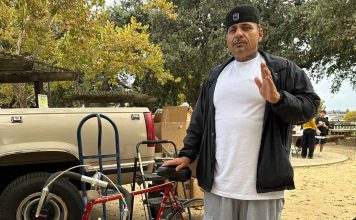Gilroy
– In response to the seemingly widespread habit of cheating at
Gilroy High School, board members and district administrators say
the issue boils down to schools, families and classroom
culture.
Gilroy – In response to the seemingly widespread habit of cheating at Gilroy High School, board members and district administrators say the issue boils down to schools, families and classroom culture.
A number of students at the high school admitted to using their cell phones to cheat by text messaging answers to tests to their friends or taking photographs of test questions with camera phones, as reported by The Dispatch last week. Students also acknowledged other methods of cheating, such as writing answers on their legs and discreetly showing the answers to nearby friends during tests.
“I was very disappointed to hear that among students, cheating is so widely accepted, or at least it appears to be that way,” said Superintendent Edwin Diaz. “If that is the case, then I think we have a serious issue that is not only a school issue, but also a family issue. … Somehow, we need to address it. How we address it, I’m not sure.”
GHS Principal Bob Bravo said he has been researching the issue of cheating in high schools across the country over the past several weeks, even before The Dispatch’s report. The problem at the high school has been ongoing and would benefit from renewed focus, Bravo said.
Diaz and Bravo said they plan to meet in the next week to discuss the issue, including looking at what preventative measures are in place now and what other steps might be taken.
“That’s probably where we need to start: at the school site to see what the specific issues are. That’s the initial step I’m taking,” Diaz said. “From the school’s perspective, it’s disappointing that there appears to be this level of an issue with cheating. Frankly, as a school, I think we shouldn’t tolerate it at all and act promptly and severely when kids are caught cheating. The same thing should happen at home.”
Policies on cheating
Neither the high school nor GUSD’s board of education has a policy regarding cheating, but that could change. Diaz and a handful of board members recently formed a sub-committee to review and update existing board policies as well as develop new ones, and a policy on cheating could result.
“When I was in school, if anyone was caught cheating, they’d get an ‘F’ on whatever they were doing. I’m not sure if or why that’s changed,” Diaz said. “In order to come up with an appropriate and consistent punishment, we’d have to sit down with teachers and site administrators and come up with a plan. Who knows at this point what the actual punishment would be, but it’s disappointing, because it’s an issue families have to deal with as well.”
Trustee Tom Bundros said he supports creating a board policy that would address several aspects of cheating, including plagiarism and copyright infringement.
“Teachers should hold high ethical expectations, but they also need the support of documented policy,” Bundros said.
A policy specific to the high school also is a possibility, which Bravo said will be discussed in the near future at one of his monthly meetings with department chairs.
“There is sort of a universal floor that if kids cheat, they get zeroes,” Bravo said. “The question would be, what would we want to do beyond that?”
If a policy came to fruition, it would need to include teacher input and address what should be considered evidence of cheating, Bravo said, as some students are quite savvy when it comes to disguising their actions.
“It’s hard sometimes to prove cheating. Sometimes it’s clear, and sometimes it’s not,” Bravo said. “A teacher might suspect it, but how do you prove it? You have to be fair. You can’t just punish someone you think, but don’t know is cheating.”
Family
Board members and administrators agree that while school site administrators and teachers need to take responsibility for cheating, accountability also lies with parents.
“Parents are the ones ultimately responsible for teaching their children that cheating is morally wrong and that someone who cheats to get a better grade is both lying and stealing,” said Trustee Rhoda Bress. “Schools must do their share to encourage honest behavior by providing safeguards in the classroom that discourage cheating.”
Students who learn at an early age that cheating is wrong are less likely to succumb to that pressure as they get older, said Trustee Pat Midtgaard.
“There are many students who have had clear values established in their lives by the time they get to high school, whether that orientation has come through parents, scouts, religious groups, sports groups or teachers,” she said. “But for the student who has not had this training and influence in their lives, a clear standard for expected behavior and achievement … is an absolute must.”
Honor code
One idea is to combat cheating is to implement an honor code, where students verbalize or sign a pledge vowing not to cheat at the beginning of the year or before each test. The high school does not have an honor code system in place to address cheating, but Bravo said from what he has researched, honor codes are a mixed bag.
“I definitely think schools need to send a message about their intention and how we want students to act and behave,” he said. “But it doesn’t mean much if there’s nothing backing it up.”
Signing a piece of paper might be a superficial solution to a complex problem, Diaz said.
“My feeling is that regardless of if students sign anything, they’re on the honor code anyway,” Diaz said. “It shouldn’t be acceptable to the school and to the families, and it shouldn’t be something that is acceptable among students.”
But Bress said she supports the creation of an honor code created with student input and presented to students, by students. The idea would work, she said, because students “who are given responsibilities and treated respectfully and honesty will, in most cases, behave responsibly, respectfully and honestly.”
How students are punished for cheating is only one part of the equation, Bravo said. Another part – a crucial part – is the quality of the relationship students share with teachers, he said.
“I think that’s probably a big part of it,” he said. “Students who have a good and trusting relationship with their teachers don’t want to let their teachers down.”
The atmosphere teachers create for constructive learning is directly tied to the decisions students make in the classroom, Midtgaard said.
“The issue is really the environment that a teacher has the obligation to create in each classroom, so that students are very clear on acceptable behaviors and expectations for how learning will occur,” she said. “Once students know what the expectations and standards are, it is their responsibility to respect them.”
Other possibilities
In March, the board will hear a presentation about Character Counts!, a nonpartisan alliance of human-service and educational organizations that advocates for character-building in cities, counties, schools and several other entities. The coalition focuses on six pillars of character: trustworthiness, respect, responsibility, fairness, caring and citizenship.
After hearing the presentation, the board will evaluate whether the program is something the district wants to become involved in.
GUSD currently has a program in place at the elementary schools called Peace Builders, which encourages students to maintain a peaceful campus. Middle schoolers take a life skills class that prepares them for the pressures and realities of high school. But neither program deals specifically with character-building in an educational atmosphere.
Also, Bravo said, is the need for site administrators and teachers to keep up with technology and its potentially deceitful uses.
“Technology just adds another layer to the problem that was there before,” he said. “From our point of view, we need to keep up on technology and ask if we’re doing all we can to mitigate the use of technology the wrong way in the classroom.”













